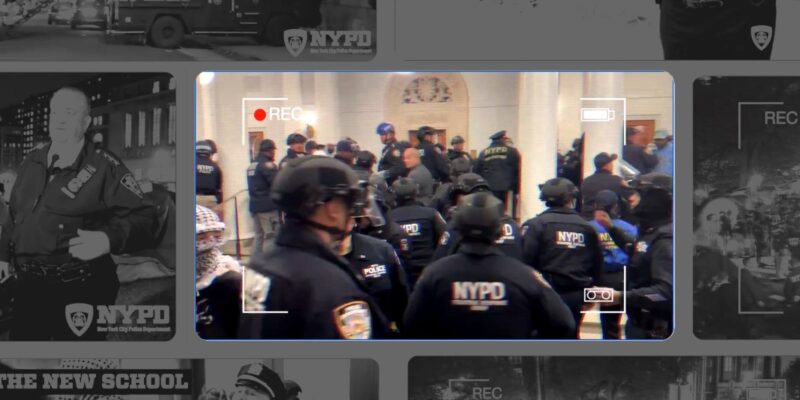
Shortly after dozens of New York City police officers gathered to clear out student protests over Israel’s war in Gaza last week, the city’s police force published something peculiar on social media: a highly produced sizzle reel of the raids.
One of the videos—posted less than 12 hours after the police raids on encampments at New York University and the New School last Friday—showed officers standing at attention as John Chell, chief of patrol for the NYPD, instructs them to remain “professional” and “firm, but fair.” Chell reminds them, “You’re dealing with children or teenagers slash young adults that aren’t at the mental capacity that you are at as professional police officers—keep that in mind.” Ominous music plays in the background as scenes of protesters wearing keffiyehs flicker across the screen. One shot showed a protester flipping off the camera.
The video was the second the NYPD released in as many days recapping their raids on student encampments at universities throughout the city. Both were roundly mocked on social media as “weird” and “embarrassing.”
But experts warn that these reels aren’t just dumb. They are also insidious forms of police propaganda that serve to justify crackdowns, often forceful, on dissent while allowing police to portray themselves as heroic. And in the process, they omit inconvenient facts.
Take, for example, the video I mentioned: Chell’s message that protesters are “children” is a glaring departure from New York City Mayor Eric Adams’ repeated insistence that officers were dealing with professional “outside agitators.” At the scene of the NYU encampment, the sizzle reel shows NYPD Deputy Commissioner of Operations Kaz Daughtry wandering around tents while suggesting that nefarious forces are at work. “Look at the water—this is very, very organized,” Daughtry is heard saying, pointing to stacks of cases of plastic water bottles. “We got water, we got supplies here, cups, coolers—somebody is definitely behind this, somebody is definitely supplying these, there is definitely a mastermind behind this.”
“This is copaganda, designed primarily to provide the mayor with political cover, but then also to show off the military might and alleged professionalism of the NYPD,” Alex Vitale, a sociologist at Brooklyn College and coordinator of the Policing and Social Justice Project, told Mother Jones.
In the early morning hours, and at the request of @NYUniversity & @TheNewSchool your @NYPDnews officers cleared the illegal encampments from their properties with unparalleled professionalism, and without incident.
It is clear that these protestors are organized and well funded.… pic.twitter.com/45TQ9WRELA
— NYPD Deputy Commissioner, Operations Kaz Daughtry (@NYPDDaughtry) May 3, 2024
The second sizzle reel, roughly four minutes and 30 seconds long, was similarly problematic in its limited focus on police preparing for the raid at Columbia before putting student protesters at Hamilton Hall in zip ties and racing through the seemingly mostly empty building during the April 30 raid. Absent from the NYPD’s reel was footage captured by students and journalists showing scenes of chaos, with police shoving students outside the building, one of whom tumbled down a flight of stairs. Nowhere in the video did it show police threatening arrest as they wielded batons. (A spokesperson for City Hall defended the NYPD’s conduct in a statement to Mother Jones, alleging that so-called outside agitators were “training students in unlawful protest tactics including barricading buildings and destruction of property.”)
Perhaps most glaringly, the NYPD video also makes no mention of an officer accidentally firing a gun inside Hamilton Hall, a fact officials only acknowledged after the local news outlet The City asked police about it. A video posted on X by Columbia Students for Justice in Palestine the night of the raid shows the close-up of an officer on their phone at the scene, texting, “thought we fucking shot someone.” (The Manhattan District Attorney’s Office is reviewing the incident, The City reported.)
These sizzle reels “are certainly not a substitute for press scrutiny,” Lauren Bonds, executive director of the National Police Accountability Project, told me. The fact that police are behind the videos, Bonds added, “really undermines the whole perspective that a journalist would provide about what was going on.” But she explained that a desire to control the narrative—thereby preventing journalists from doing so—is likely the driving force behind the videos, particularly as the NYPD have become increasingly hostile towards the press.
Such hostility was on display during the Columbia raid, as police were seen barring media from entering the campus and forcing student journalists to disperse. Controversial social media strategies by the police extend beyond student protests. Chell specifically has a history of using social media to go after individual reporters who are critical of police, a tactic the mayor has defended. In a since-deleted post, Chell also went after Councilmember Tiffany Cabán for calling the encampment raids “authoritarian,” prompting more than 30 local elected officials to ask the mayor’s office to formally reprimand Chell over his behavior on social media.
“There’s a deep culture of defensiveness, not just within the NYPD but within policing in general,” Vitale told me. “They feel deeply aggrieved about any criticism, and they hold a grudge.”
Both Vitale and Bonds also see another potential motivation behind the NYPD’s sizzle reels: recruitment of more cops, an effort the NYPD and police departments across the country have been struggling with in recent years as public criticism of policing has mounted.
“It’s kind of this good versus evil, larger than life dynamic,” Bonds said of the sizzle reels. “This would be a really great tool to for them if they wanted to make the profession of policing look more appealing.”
As you might expect, the NYPD did not respond to a half dozen detailed questions from Mother Jones for this story.















